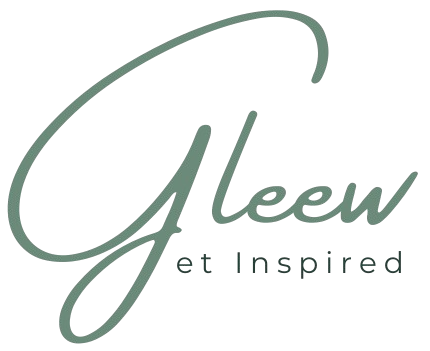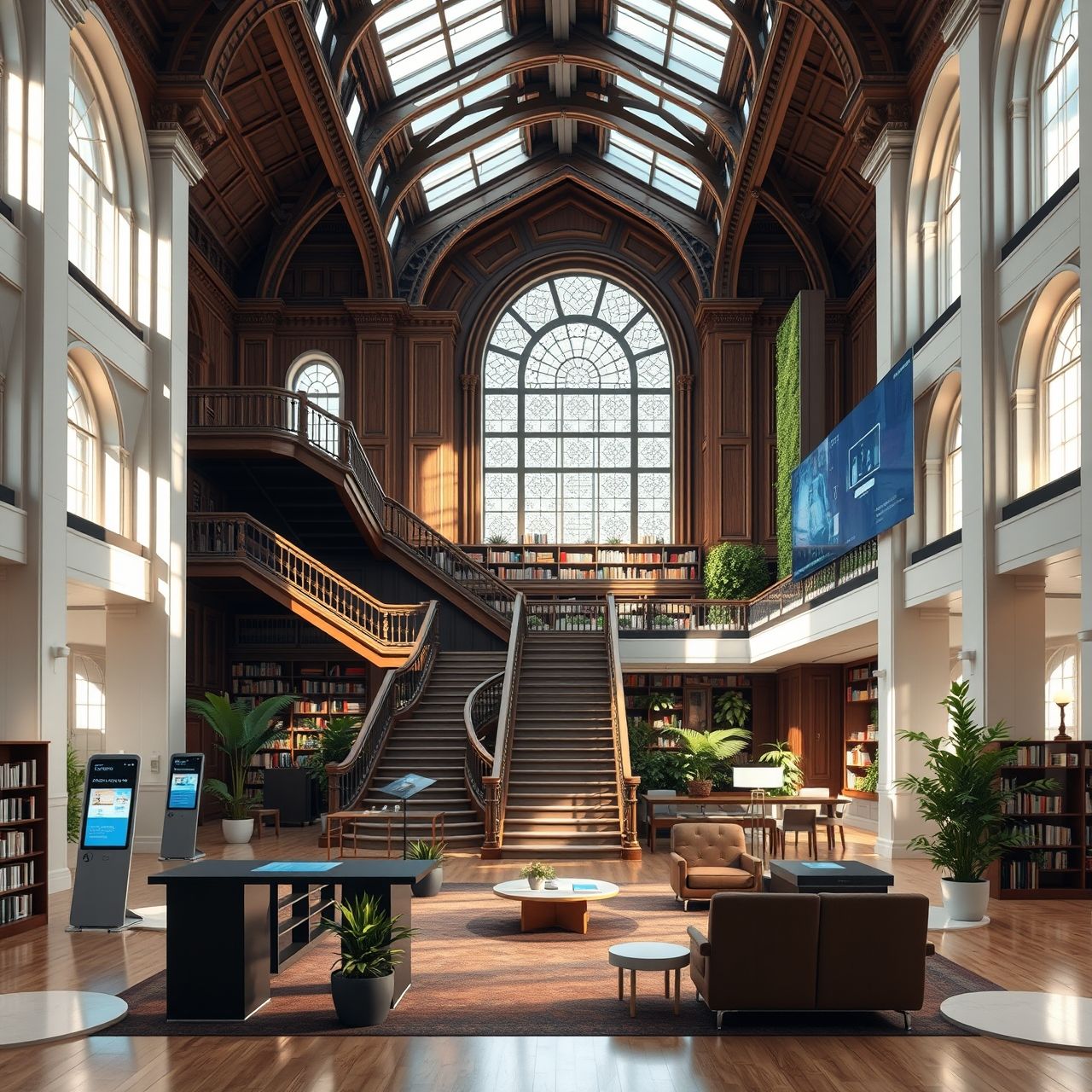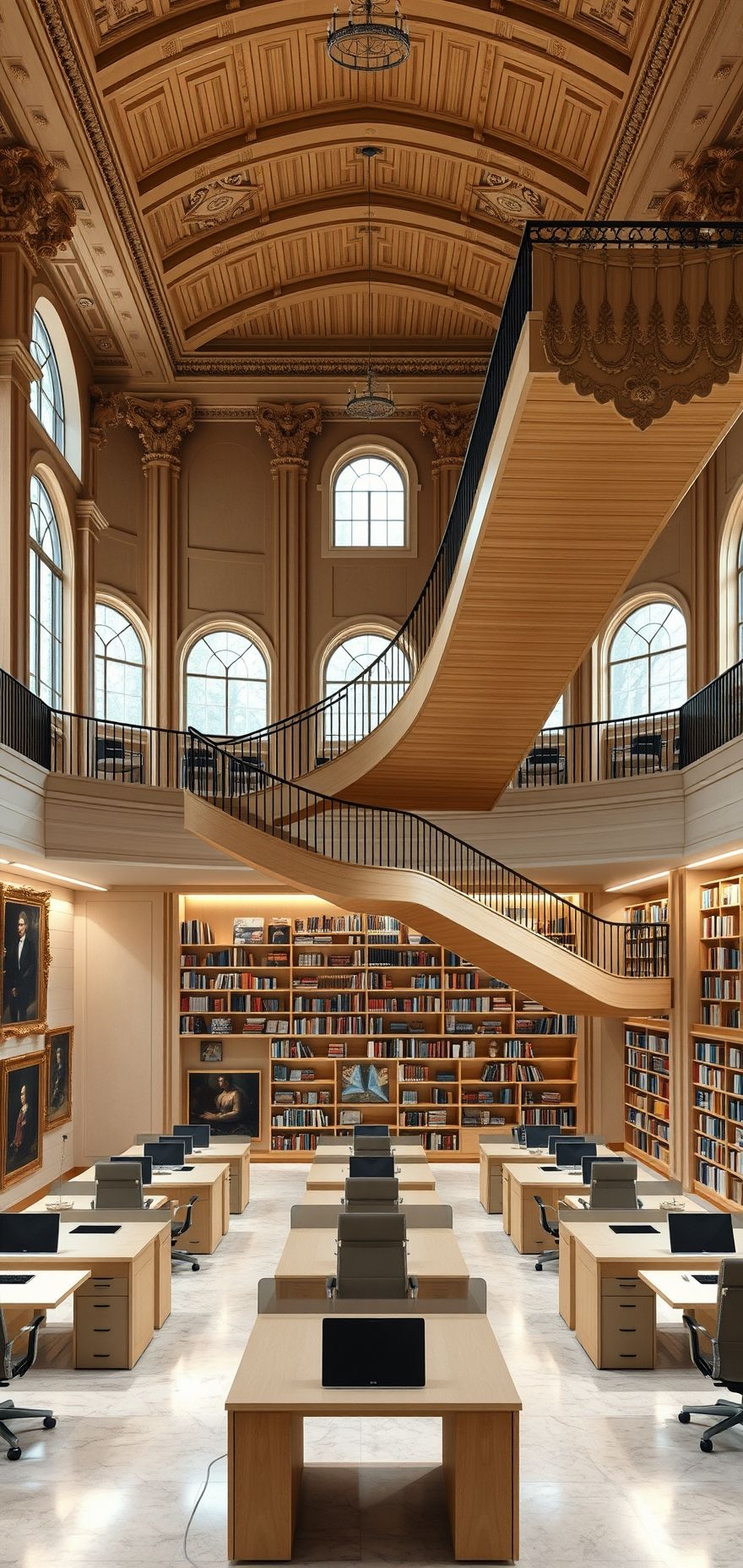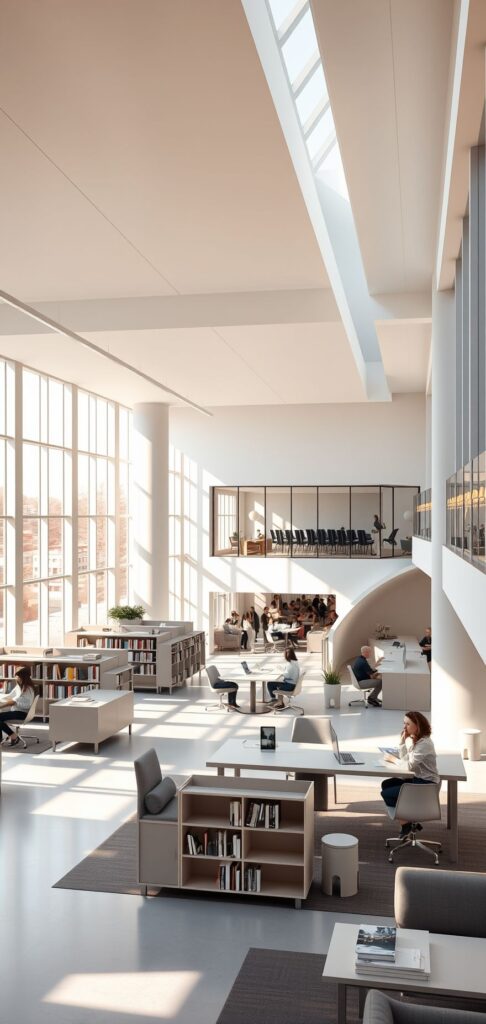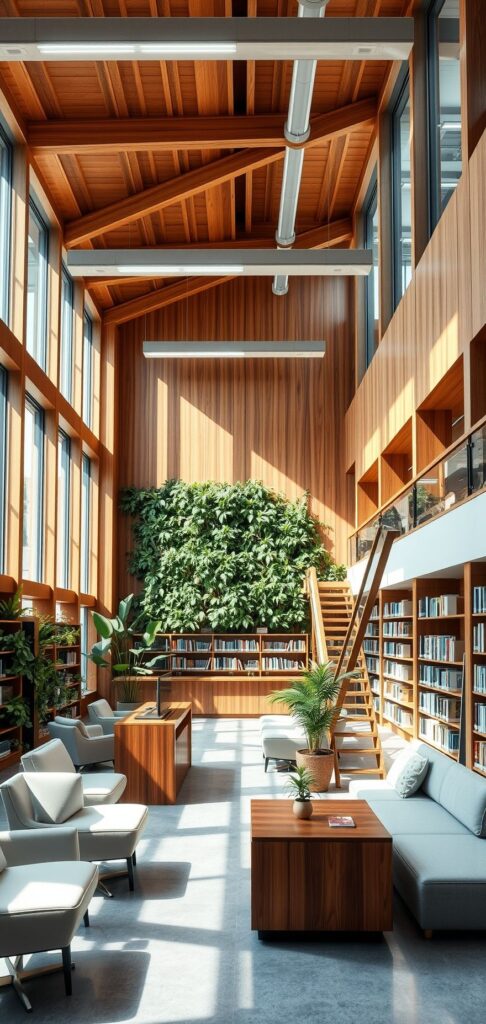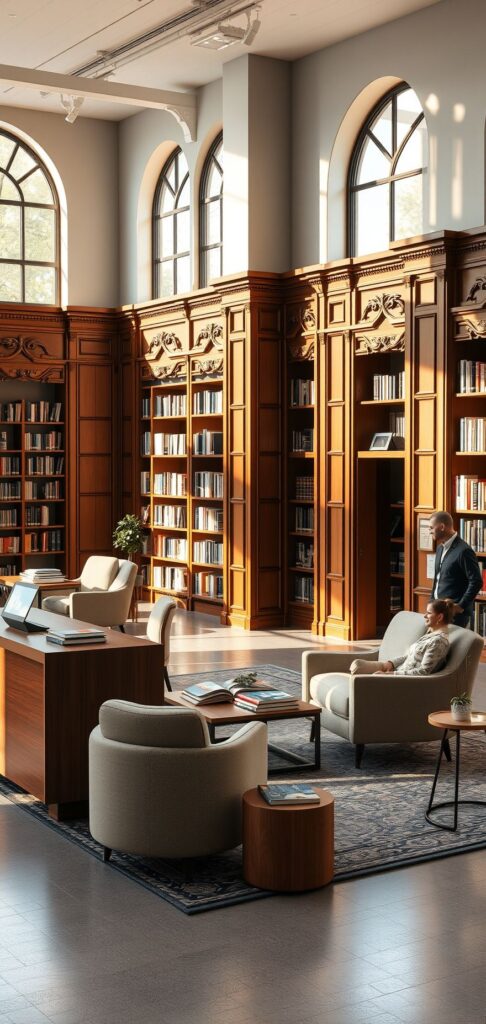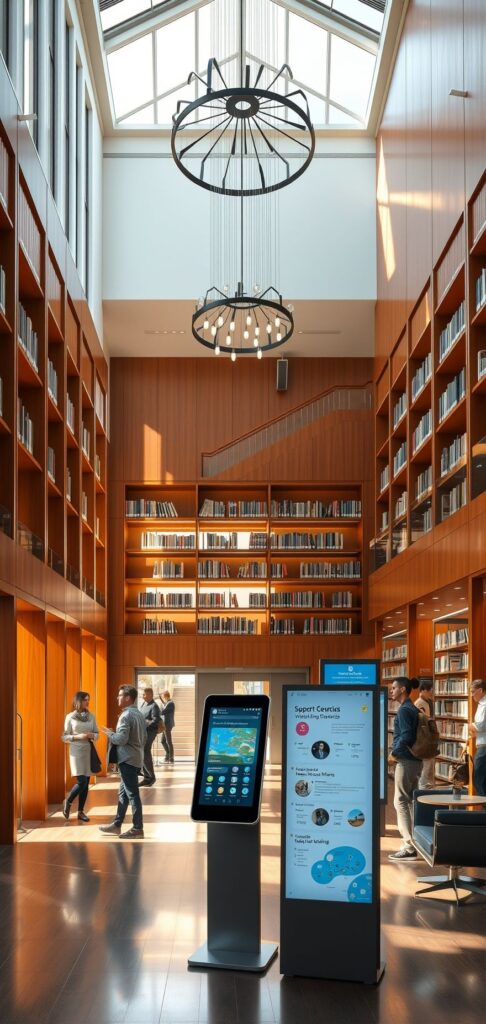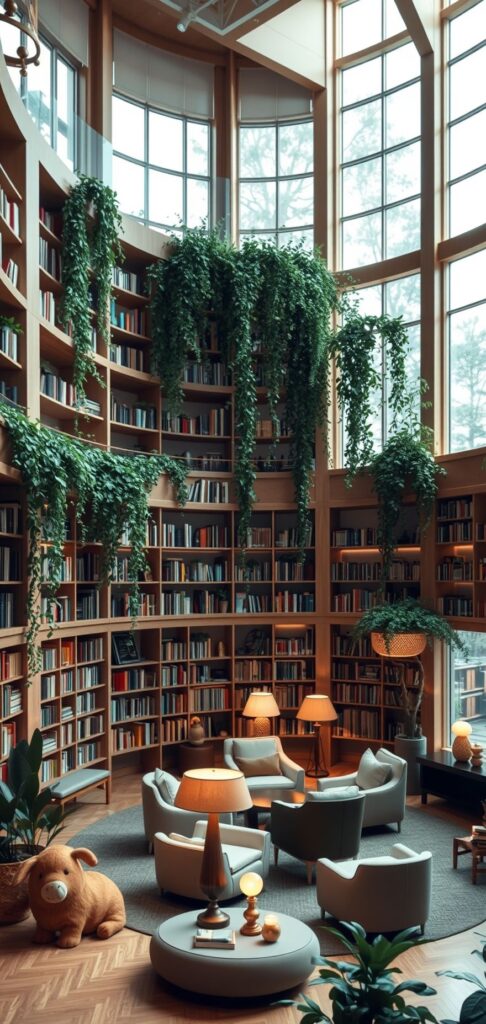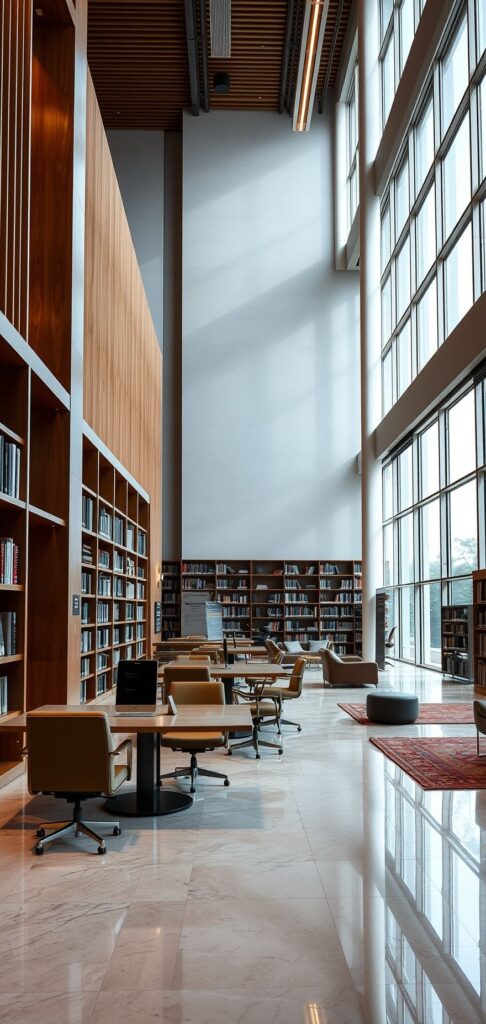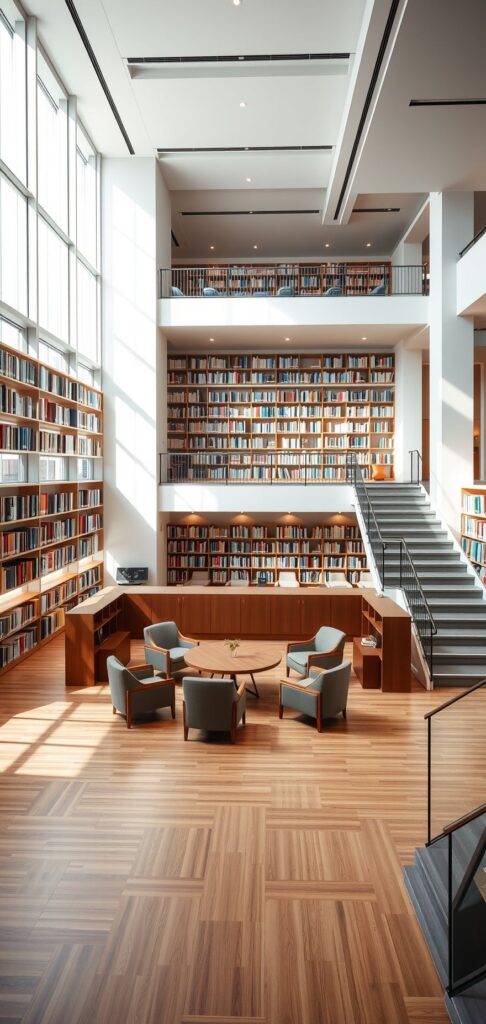Key Takeaways
- Fusing Tradition with Innovation: Modern library design seamlessly integrates traditional architectural elements with cutting-edge technologies, creating spaces that honor the past while embracing the future.
- Multipurpose Spaces for Diverse Needs: Libraries are transforming into flexible, multipurpose spaces that cater to a wide range of activities, from quiet study areas to collaborative workstations and community event spaces.
- Sustainability at the Forefront: Green library design prioritizes eco-friendly materials, energy-efficient systems, and natural light, promoting environmental responsibility and reducing operational costs.
- Community-Centric Design: Involving the community in the design process ensures that libraries reflect local needs and preferences, fostering a sense of ownership and belonging among users.
- Innovative Technologies Enhance Experience: The integration of advanced technologies, such as digital kiosks, interactive displays, and automated systems, enhances user experience and streamlines library operations.
- Psychological Well-being Through Design: Thoughtful library design can positively impact users’ mental health by creating calm, inspiring spaces that reduce stress and promote a sense of well-being.
- User Experience as a Priority: Modern libraries are designed with a focus on user comfort and accessibility, ensuring that all visitors can navigate and utilize the space with ease.
- Architectural Trends Shaping Libraries: Contemporary architectural trends in library design emphasize open floor plans, natural materials, and biophilic elements, creating inviting and visually appealing environments.
Did you know that the earliest libraries date back to 2600 BCE, serving as archives for clay tablets? Fast forward to today, and library design has evolved far beyond mere storage spaces, transforming into vibrant, multifunctional hubs that cater to a wide range of community needs. As we blend classic elements with modern innovations, libraries are becoming more than just repositories of knowledge—they’re evolving into dynamic spaces that inspire, educate, and connect communities.
Understanding the latest trends in library design can help us create spaces that are not only functional but also emotionally enriching. From integrating sustainable practices to incorporating advanced technologies, modern libraries are adapting to meet the diverse needs of their users.
Let’s explore how these trends are shaping the future of libraries, making them more versatile, eco-friendly, and user-centric than ever before.
Fusing Tradition with Innovation
Blending Classic and Modern Elements
In the realm of library design, blending classic and modern elements has become a hallmark of contemporary spaces. Traditional architectural features like grand staircases, ornate moldings, and high ceilings are being seamlessly integrated with sleek, modern design elements such as minimalist furniture, open floor plans, and cutting-edge technology. A prime example is the Birmingham Library in the UK, which masterfully combines a historic façade with a modern library building interior, creating a harmonious blend of old and new. This approach not only preserves the cultural heritage but also caters to the evolving needs of modern users, setting a benchmark in library design trends.
Embracing Technology in Library Design
Technology has become an integral part of modern library design, transforming how users interact with these spaces. Incorporating digital kiosks, interactive displays, and automated systems enhances the user experience significantly. For instance, the Seattle Central Library features automated book sorting systems and interactive digital displays that guide users through the collection. These technological integrations not only streamline operations but also make the library more accessible and engaging for visitors of all ages.
Multipurpose Spaces for Diverse Needs
Designing for Versatility
Creating flexible and adaptable spaces is crucial in modern library design. Libraries are no longer just repositories of books; they serve as community hubs for study, collaboration, and various events. The Halifax Central Library in Canada exemplifies this trend with its open, flexible layouts and versatile furniture choices. Movable shelves, modular seating, and multi-use rooms allow the space to adapt to different activities, from quiet study to collaborative projects. This versatility ensures that the library can meet the diverse needs of its patrons effectively.
Community Event Spaces
Designing areas specifically for workshops, lectures, and social gatherings has become a key aspect of library design. Flexible seating arrangements and adaptable spaces ensure that libraries can host a variety of events, from small group meetings to large community gatherings. The Austin Central Library in Texas is a notable example, featuring a rooftop garden and an event center that can accommodate large crowds. These spaces not only enhance the library’s functionality but also foster a sense of community and belonging among visitors.
Sustainability at the Forefront
Green Library Design Principles
Sustainable library design is gaining traction as libraries aim to reduce their environmental footprint. Utilizing eco-friendly materials, energy-efficient systems, and maximizing natural light are some of the key principles. The Vancouver Public Library‘s Central Branch is a shining example, with its green roof, rainwater harvesting system, and extensive use of natural light. These features not only reduce energy consumption but also create a more inviting and comfortable environment for visitors.
Environmental Responsibility
Strategies for reducing operational costs through sustainable design are becoming increasingly important. For example, the Melbourne Library at The Dock incorporates passive cooling systems and solar panels, resulting in significant energy savings. Case studies of eco-friendly libraries, such as the Copenhagen Public Library, demonstrate that sustainable design can lead to substantial cost savings and environmental benefits. These libraries serve as models for how sustainable library design can be both economically and environmentally beneficial.
Community-Centric Design
Involving the Community
Engaging local residents in the library design process ensures that the final product reflects the community’s needs and preferences. The Denver Public Library involved community members in the design process, resulting in a space that truly resonates with the local population. This approach fosters a sense of ownership and belonging, making the library a cherished community asset.
Fostering Ownership and Belonging
Creating spaces that resonate with the community is essential for community-focused library design. The Chicago Public Library‘s Chinatown Branch is a testament to this, with its design reflecting the cultural heritage of the neighborhood. This not only makes the library more inviting but also strengthens the bond between the library and the community it serves.
Innovative Technologies Enhance Experience
Digital Integration
Implementing digital kiosks and interactive displays is becoming standard in modern library design. The San Diego Central Library features automated check-out systems and digital wayfinding kiosks, making it easier for visitors to navigate and use the library. These technological integrations enhance the overall user experience, making the library more efficient and user-friendly.
User Experience Enhancements
Technology plays a crucial role in improving library navigation and usability. The Salt Lake City Public Library uses RFID technology for quick and easy check-out, reducing wait times and enhancing the overall experience. Real-world examples of tech-enhanced libraries, such as the Amsterdam Public Library, demonstrate how technology can transform the way users interact with library spaces.
Psychological Well-being Through Design
Creating Calm and Inspiring Spaces
Design elements that promote mental well-being are increasingly important in library design. Using natural materials and biophilic design can create calming and inspiring spaces. The Helsinki Central Library Oodi incorporates natural wood and plenty of greenery, creating a soothing environment that enhances user well-being. This thoughtful design approach not only makes the library more inviting but also supports the mental health of its visitors.
Reducing Stress and Enhancing Well-being
Strategies for creating relaxing and inspiring environments are essential for modern libraries. The Dokk1 Library in Aarhus, Denmark, uses soft lighting, comfortable seating, and quiet spaces to reduce stress and enhance well-being. The impact of thoughtful design on user experience is profound, making the library a place where visitors can find solace and inspiration.
User Experience as a Priority
Designing for Comfort and Accessibility
Ensuring that all visitors can navigate and utilize the space easily is a top priority in library design. Accessible design features, such as wide aisles, adjustable furniture, and clear signage, are crucial. The Seattle Public Library‘s Central Branch is a model of accessibility, with its user-friendly layout and inclusive design features.
User-Centric Approaches
Prioritizing user needs in design decisions is essential for creating user-friendly libraries. Examples of user-friendly library design, such as the Calgary Central Library, demonstrate how a user-centric approach can transform the library experience. From comfortable seating to intuitive navigation, every aspect of the design is tailored to meet the needs of the users.
Architectural Trends Shaping Libraries
Open Floor Plans
Open and inviting layouts are becoming increasingly popular in library design. The Boston Public Library‘s renovation features an open floor plan that encourages exploration and interaction. This design trend not only makes the library more welcoming but also enhances the overall user experience.
Natural Materials and Biophilic Elements
Incorporating nature-inspired design elements creates visually appealing and inviting environments. The Oslo Public Library uses natural materials and biophilic elements to create a serene and inspiring space. This approach not only enhances the aesthetic appeal of the library but also contributes to the well-being of its visitors.
Modern library design is evolving to blend tradition with innovation, creating spaces that are not only aesthetically pleasing but also highly functional and sustainable. By integrating classic architectural elements with contemporary design, embracing advanced technologies, and prioritizing sustainability, libraries are transforming into versatile community hubs. These spaces cater to diverse needs, from quiet study to collaborative events, and foster a sense of belonging and ownership within the community. As libraries continue to adopt user-centric and environmentally responsible designs, they will remain vital institutions that support learning, engagement, and well-being. Looking ahead, the challenge for architects and designers will be to continually adapt these spaces to meet the ever-changing needs of their users, ensuring that libraries remain at the heart of our communities.
